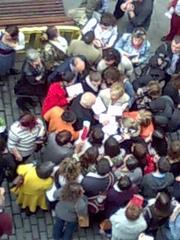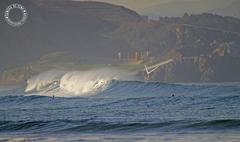Visiting Palacio Valdés Bazán: Hours, Tickets, and Tips
Date: 01/08/2024
Introduction
The Palacio de Valdés-Bazán in Avilés, Spain, is a remarkable historical and architectural landmark that offers visitors a unique glimpse into the rich cultural heritage of Asturias. Originally constructed in the 16th century, this noble rural residence, also known as the Palacio de los Cuervo-Arango or the Palacio de los Condes de Reparaz, has undergone significant transformations over the centuries. Its classical appearance today is largely due to extensive renovations in the 17th and 18th centuries under the ownership of Fernando de Valdés y Quirós, who added family crests and other architectural details that symbolize the union of the Valdés and Cuervo families (Wikipedia).
The palace’s architectural evolution, from its austere 16th-century origins to its grander 18th-century form, makes it a fascinating study for both history buffs and architecture enthusiasts. It has been the residence of several notable noble families, including the Cuervo Arango, Quirós, and Valdés families. Figures such as José de Valdés y Flórez, a prominent figure in the Spanish Navy, and Fernando Antonio de Valdés y Quirós, who spearheaded the palace’s transformation, highlight its noble heritage (Wikipedia).
Declared a Bien de Interés Cultural (BIC) on December 28, 1982, the Palacio Valdés Bazán is recognized for its cultural significance and architectural splendor. Its role during the Spanish Civil War as a field hospital adds another layer to its historical narrative, showcasing its adaptability and importance during times of crisis (Patrimonio Arquitectónico de Asturias). Today, as a municipal property, it continues to be a symbol of Asturias’ noble heritage and architectural excellence, open to visitors eager to explore its storied past and stunning features.
Table of Contents
- Introduction
- Origins and Early Construction
- Architectural Evolution
- Genealogical History
- Architectural Features
- Visitor Information
- Travel Tips and Nearby Attractions
- Historical Significance
- Transition to Municipal Ownership
- FAQ
- Conclusion
Origins and Early Construction
The origins of the Palacio de Valdés-Bazán date back to the 16th century. The original structure featured a simple and austere design, typical of the period. Significant renovations in the 17th and 18th centuries under the ownership of Fernando de Valdés y Quirós transformed the palace into its current classical appearance, complete with the family crests of the Valdés and Cuervo families (Wikipedia).
Architectural Evolution
The architectural evolution of the palace can be divided into two main phases. The first phase involved the initial 16th-century construction, marked by simplicity and austerity. The second phase in the 18th century, under Fernando de Valdés y Quirós, brought extensive modifications that enhanced its grandeur. The addition of family crests to the façade symbolizes the union of the Valdés and Cuervo lineages (Wikipedia).
Genealogical History
The Palacio de Valdés-Bazán boasts a rich genealogical history, having been passed down through several noble families, including the Cuervo Arango, Quirós, and Valdés families. Notable figures such as José de Valdés y Flórez, a prominent figure in the Spanish Navy, and Fernando Antonio de Valdés y Quirós, responsible for the palace’s transformation, highlight the palace’s noble heritage (Wikipedia).
Notable Figures
José de Valdés y Flórez
A distinguished member of the Valdés family, José de Valdés y Flórez, held several important positions, including Chief of Squadron in the Royal Navy and elected deputy to the Cortes. His contributions to Spanish nobility and maritime history are well-documented (Wikipedia).
Fernando Antonio de Valdés y Quirós
Fernando Antonio de Valdés y Quirós played a crucial role in the architectural transformation of the palace. His extensive renovations in the 18th century gave the palace its current classical form. He held various significant positions, including Assistant and Superintendent of Seville and General Intendant of the troops in Andalusia (Wikipedia).
Architectural Features
Situated at the edge of San Román de Candamo, the Palacio de Valdés-Bazán is organized in a rectangular plan, adapting to the local topography. It features a main north façade adorned with noble emblems and a geometric irregularity that blends austerity and ruralism. The west façade follows similar design principles, incorporating galleries without introducing new elements (Wikipedia).
Visitor Information
- Visiting Hours: The palace is open to visitors from Tuesday to Sunday, 10 AM to 6 PM.
- Ticket Prices: General admission is €5, with discounts for students and seniors. Children under 12 enter for free.
- Guided Tours: Guided tours are available in Spanish and English. It is recommended to book in advance.
- Special Events: The palace occasionally hosts cultural events and exhibitions. Check the official website for upcoming events.
Travel Tips and Nearby Attractions
- Travel Tips: Wear comfortable shoes as the palace grounds are extensive. Photography is allowed, but flash photography is prohibited inside the palace.
- Nearby Attractions: Visit the Cave of La Peña, known for its prehistoric paintings, and the nearby town of Grado, famous for its traditional market.
Historical Significance
The Palacio de Valdés-Bazán holds significant historical value due to its association with prominent noble families and its architectural evolution over the centuries. The palace has served as a residence for various noble lineages, each contributing to its history and legacy (Wikipedia).
Role During the Spanish Civil War
During the Spanish Civil War (1936-1939), the Palacio Valdés Bazán served a critical role as a field hospital. This period was marked by significant turmoil and conflict, and the palace’s transformation into a medical facility underscores its adaptability and importance in times of crisis. Despite the damage it sustained during the war, the palace managed to retain much of its original architectural integrity, with only minor repairs needed post-war (Explorial).
Transition to Municipal Ownership
In the late 20th century, the palace transitioned from private to municipal ownership, marking a new chapter in its history. This change has ensured the palace’s preservation and accessibility to the public, allowing visitors to appreciate its historical and architectural significance (Wikipedia).
FAQ
Q: What are the visiting hours for Palacio de Valdés-Bazán? A: The palace is open from Tuesday to Sunday, 10 AM to 6 PM.
Q: How much are the tickets? A: General admission is €5, with discounts for students and seniors. Children under 12 enter for free.
Q: Are guided tours available? A: Yes, guided tours are available in Spanish and English. It is recommended to book in advance.
Q: Are there any special events? A: The palace occasionally hosts cultural events and exhibitions. Check the official website for upcoming events.
Conclusion
The history and architectural splendor of the Palacio de Valdés-Bazán make it a valuable cultural landmark in Asturias. From its origins in the 16th century to its transformation under the Valdés family in the 18th century, the palace has witnessed significant historical events and changes. Today, as a municipal property, it continues to be a symbol of Asturias’ noble heritage and architectural excellence. Plan your visit to this remarkable site and immerse yourself in its rich history and beauty.
Call to Action
For the latest updates on visiting hours, ticket prices, and special events, be sure to visit the official website. Follow us on social media for more information and updates on other historical sites in Asturias.
References
- Wikipedia. Palacio de Valdés-Bazán. Retrieved from Wikipedia.
- Patrimonio Arquitectónico de Asturias. (2014). Palacio de Valdés Bazán, San Román de Candamo. Retrieved from Patrimonio Arquitectónico de Asturias.
- Explorial. Avilés Teatro Palacio Valdés. Retrieved from Explorial.
- Teatro Palacio Valdés. Retrieved from Teatro Palacio Valdés.
- Spain This Way. Avilés. Retrieved from Spain This Way.

